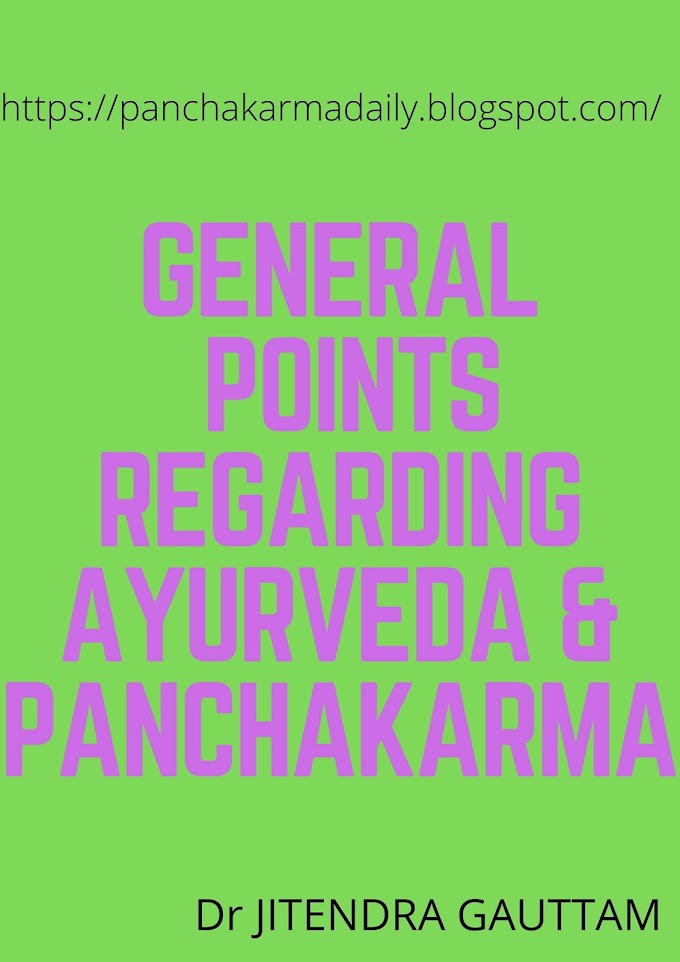Application of Sneha in some specific direction
is simply termed as Abhyanga. Abhyanga is an important
therapeutic method and is the most commonly Panchakarma therapy for both
healthy and diseased person. Ayurvedic massage therapy is not just the simple
application of oil and massage as it is understood by most people. It involves therapeutic
consideration, such as Dosha, Dhatu, Prakriti and pharmacological
consideration. The therapeutic efficacy of massage therapy depends on
appropriate selection of oil according to the disease, Prakriti, the
skill of the therapist, the cooperation of the patient, and any restriction
that need to be followed by the patient during and after treatment. It is practiced
commonly in our daily life. For this purpose, generally oil is used though Sarpi,
etc. may be applied.
ABHYANGA
The technique of Abhyanga differs as per the body part
involved or according to the disease.
REQUIREMENT
1. Sneha- Medicated oil or any common oil such as mustard
oil, sesame oil or coconut oil.
2. Masseur (therapist)
3. Abhyanga table (Droni)
4. Towel
5. Gas oven or induction for heating Sneha. Sneha
should never be heated directly on fire.
PRECAUTIONS BEFORE ABHYANGA
Following things are to be considered before application of Abhyanga:
1. The person should pass his natural urges.
2. Person should not be hungry.
3. Person should not take food prior to therapy.
4. Person should be suitable for Abhyanga.
POSTURE
Posture of the patient should be so that Abhyanga can
be done of the whole body in each and every part.
Abhyanga primarily can be divided into two types.
1. Sarvanga Abhyanga (full body massage)
2. Ekanga Abhyanga (particular body part massage)
For Sarvanga Abhynaga (full body massage), Abhyanga
is done in seven positions:
1. Sitting position with both leg extended.
2. Lying position (Supine posture).
3. Left lateral position.
4. Supine position.
5. Right lateral position.
6. Supine position
7. Sitting position with both leg extended.
DIRECTION OF ABHYANGA
Generally, the direction of Abhyanga should be Anulomana.
According to the body part direction of the massage is changed. Different kinds
of direction or Anuloma Gati are mentioned below:
- In hair follicles body part- In general, Abhyanga should be done in the direction of hair.
- In muscle fibres- Direction should be from muscle origin to muscle insertion.
- For spine- Direction toward coccyx is Anulomana, though in specific condition, its opposite direction is also granted.
- Abdomen- Direction toward large intestine is Anulomana.
- Umbilicus- A circular movement is carried out around umbilicus.
- In upper and lower limbs- Anulomana is massage from upwards to the tip of fingers.
- Joints- Abhyanga over different joints should be done in circular direction.
ABHYANGA KALA
Sneha (oil) used in Abhyanga reaches to the hair
follicle in 95sec (300 Matra). It reaches to Twacha (skin), Rakta
(blood), Mansa (muscular system), Meda (Adipose tissue), Asthi
(Skeltal System) and Majja (Bone marrow) in 400 Matra (127 sec),
500 Matra (159 sec), 600 Matra (190 sec), 700 Matra (220 sec),
800 Matra (254 sec) and 900 Matra (285 sec) respectively.
DHATU MATRA KALA Time/Sec
Romante (hair follicle) 300 Matra (95 Sec)
Twacha (skin) 400
Matra (127 sec)
Rakta (blood) 500 Matra (159 sec)
Mansa (muscular system) 600 Matra (190
sec)
Meda (Adipose tissue) 700
Matra (220 sec)
Asthi (Skeltal System) 800
Matra (254 sec)
Majja (Bone marrow) 900 Matra (285 sec)
BENEFITS OF ABHYANGA
अभ्यङ्गंमचरेत्नित्यं
स जराश्रमवताह |
दृष्टिप्रसादपुष्ट:
आयु: स्वप्न सुत्वकवदाडार्यकृत् ||
शिर:श्रवणपादेषु
तं विशेषेण शिलियेत् | (अ.ह.
सू. २/८-९ )
- Jarahara- It prevents and corrects ageing process.
- Shramahara- It helps a person to overcome fatigue due to hard work.
- Vatahara- it corrects and prevents disorders caused by affliction of Vata.
- Dristiprasadakara- It promotes eye sight.
- Pustikara- It helps in nourishment of the body.
- Ayushyakara- It promotes longevity.
- Swapanakara- It helps the individuals to get sleep.
- Twakdhadharyakrita- It promotes sturdiness of an individual.
ABHYANGA OF HEAD REGION, EARS AND LEGS SHOULD BE
DONE IN PARTICULAR.
CONTRAINDICATION
- Kapha predominant disease.
- Patient undergone Vaman or Virechana Karma.
- Suffering from indigestion.
- Persons having Sama-Dosha.




0 Comments